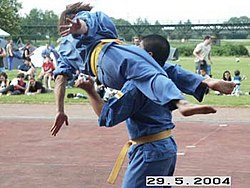Vietnamese martial arts
Schools of martial arts in Vietnam From Wikipedia, the free encyclopedia
Traditional Vietnamese martial arts (Võ thuật Cổ truyền Việt Nam; Chữ Hán: 武術古傳越南) often referred to as Võ thuật (Chữ Hán: 武術), can be loosely divided into those of the Sino-Vietnamese descended from the Han and those of the Chams or indigenous Vietnamese.
This article needs additional citations for verification. (October 2016) |




Traditional schools


- Võ thuật Bình Định/Bình Định Gia – umbrella title for all the traditional styles of Bình Định in central Vietnam.
- Võ Lâm Tân Khánh Bà Trà - The Tân Khánh martial arts was established in the 17th century. It was developed as a method of self-defense against enemies and wild animals.[1]
- Traditional Vietnamese wrestling.
Modern schools
Modern styles, or Phái (schools), include:
- Nhất Nam
- Vovinam – Founded by Nguyễn Lộc. Also called Vovinam Việt Võ Đạo (Việt = Vietnamese, Võ = martial, Đạo = way)
- Võ Việt Nam (Cuton) or Võ Đạo of Phạm Văn Tan.[2]
- Vietnamese Wing Chun - a style of Wing Chun founded by Yuen Chai-wan.[3]
- Overseas
- Cuong Nhu of Ngô Đồng (d. Florida 2000), known also by the Japanese title O Sensei.
- Qwan Ki Do, founded in France.[4]
- Tam Qui Khi-Kong, now popular in Russia.
- Traditional Vietnamese wrestling.
Terminology
- võ sư – master
- võ phục – tunic
- võ kinh – martial arts scripture
- Võ Bắc Việt – Northern Vietnam style
- quyền – fist, such as Hùng kê quyền, Hồng Gia quyền, Lão mai quyền
- Võ thuật Bình Định – martial arts of Bình Định
- Đấu vật – ring wrestling (can also mean western wrestling)
- Hand techniques (đòn tay)
- Elbow techniques (chỏ)
- Kicking techniques (đá)
- Knee techniques (gối)
- Forms (Quyền, Song Luyện, Đa Luyện)
- Attack techniques (chiến lược)
- Traditional wrestling (Vật cổ truyền)
- Leg Attack take-downs (đòn chân tấn công)
- Staff (côn)
- Sword (kiếm)
- Halberd (dao dài, "long knife")
- Rope dart/chain whip (nhuyễn tiên, different from Chinese rope dart)
- Khăn rằn - The khăn rằn is a southern scarf that originated from the Khmer krama scarf.[5] The khan ran can be used to lock the enemy's arm, lock the enemy's wrist, lock the enemy's leg, pull the enemy's leg and to attack the enemy's face.[6]
Gallery
- An illustration of a martial arts competition in the Nguyễn dynasty – Part 1
- An illustration of a martial arts competition in the Nguyễn dynasty - Part 2.1
- An illustration of a martial arts competition in the Nguyễn dynasty – Part 2.2
- An illustration of a martial arts competition in the Nguyễn dynasty – Part 3
- Master Hà Dũng performs nunchaku
See also
References
Wikiwand - on
Seamless Wikipedia browsing. On steroids.




